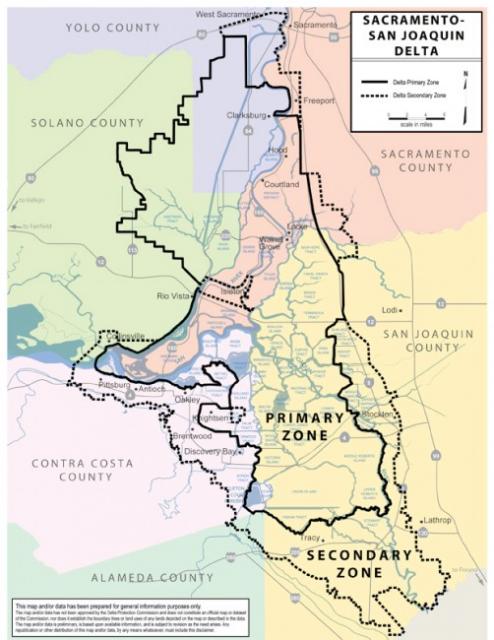Sacramento-San Joaquin Delta Land Use and Boundaries
The Sacramento-San Joaquin Delta includes approximately 500,000 acres of waterways, levees and farmed lands extending over portions of six counties: Alameda, Contra Costa, Sacramento, San Joaquin, Solano and Yolo.
The rich peat soil in the central Delta and the mineral soils in the higher elevations support a strong agricultural economy. The Delta islands have access to the fresh waters of the 700 miles of rivers and sloughs lacing the region. These waterways and the uplands provide habitat for fish, amphibians, reptiles, mammals, and birds, including several rare and endangered species such as the Delta smelt.
Sacramento-San Joaquin Delta Land Use and Boundaries Background
To understand how Sacramento-San Joaquin Delta took shape, it helps to step back in time.
Developers first thought levees 4 feet high and 12 feet at the base would protect Delta lands from tides and river overflow, but that proved inadequate for the Delta peat soils. Originally, settlers planned to transform marshes into islands.
By 1869, for instance, substantial levees had been constructed on Sherman Island and Twitchell Island by Chinese laborers, and the owners reaped bountiful harvests of grain and row crops the subsequent year.
Small-scale reclamation projects were later started on Rough and Ready Island and Roberts Island in the 1870s. But the peat soils showed their weakness as levees – sinking, blowing away and developing deep cracks and fissures throughout the levee system. Sherman and Twitchell Islands flooded annually in the early 1870s.
In the late 1870s steam-powered dredges began to be used to remove large volume of alluvial soils from the river channels to construct larger levees.
The peak of Delta land reclamation was reached with the clamshell-type dredge, still commonly used. After World War I, the number of operating dredges decreased greatly, as nearly all Delta marshland had been reclaimed. By this time, the Delta had been transformed from marshland to the improved channels and leveed islands we know today.
Sacramento-San Joaquin Delta Land Use and Boundaries Today
Today, the Primary Zone—statutorily defined in 1988 as comprising “Delta land and water area of primary state concern and statewide significance” —includes approximately 500,000 acres of waterways, levees and farmed lands extending over portions of six counties: Alameda, Contra Costa, Sacramento, San Joaquin, Solano and Yolo.
Recognizing threats to the Primary Zone from potential urban and suburban encroachment and the need to protect the area for agriculture, wildlife and recreation, the Delta Protection Act was enacted in 1992. The Act directs the Delta Protection Commission to prepare a comprehensive resource management plan for land uses within the Primary Zone of the Sacramento San Joaquin Delta Plan.
Projects in the Secondary Zone are subject to Commission review through the California Environmental Quality Act but are not subject to appeal. The Delta’s Secondary Zone, which includes the cities of Stockton, Lathrop, Tracy, Oakley, and West Sacramento, is defined as that part of the Delta where development can occur. Development projects in the Secondary Zone are primarily subject to local land use decisions.
The Commission provides comments on those projects in the Secondary Zone having the potential to impact the Primary Zone. While the provisions of the Act and the oversight of the Commission have been, for the most part, effective in the Primary Zone, there is increasing pressure for development in the Secondary Zone.









